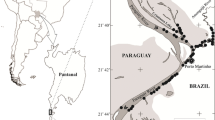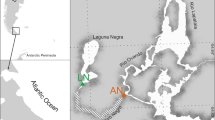Abstract
Accurate descriptions of reproductive profiles are important for effective conservation and stock assessment efforts. We examined the reproductive traits of an Okinawan population of western Pacific gizzard shad (Nematalosa come) using histological analyses. The observed lengths at 50 % maturity were approximately 180 mm standard length (SL) for females and 130 mm SL for males, which corresponded to 4-year-old fish for females and at least 2-year-old fish for males. The spawning season was estimated to occur from January to August, peaking from March to June, with active spawning occurring during an increase in seawater temperature. The lipidosomatic index of both sexes decreased until June, presumably as the fish expended energy to spawn. The fecundity (F) of females, tested using 62 ovaries, was related to SL: F = 3.471 × 10−2 × SL3.122. The Okinawan population of N. come had a longer spawning season and a higher fecundity than other populations for which these data are available. Such favorable traits may contribute to the persistence of this population at the species’ distributional margin. Our findings indicate that the spawning seasons of Okinawan populations of N. come and Nematalosa japonica overlapped, implying that hybrid production occurs under natural conditions. Around Okinawa Island, however, the extent of shallow waters is rapidly decreasing because of recent land reclamation. We suggest the diminution of suitable sites as a possible factor for narrowing spawning opportunities and promoting the recent appearance of natural hybrids. Shallow habitats should be conserved to preserve healthy populations of the species.






Similar content being viewed by others
References
Aonuma Y (2002) Clupeidae. In: Nakabo T (ed) Fishes of Japan with pictorial keys to the species, Englishth edn. Tokai University Press, Tokyo, pp 243–247
Campton DE (1987) Natural hybridization and introgression in fishes: methods of detection and genetic interpretations. In: Ryman N, Utter F (eds) Population genetics and fishery management. University of Washington Press, Seattle, pp 161–192
Chen MH, Hsiao JS (1996) The reproductive biology of the gizzard shad, Nematalosa come (Richardson, 1846), in the Kaohsiung River and its harbor area, southern Taiwan. Zool Stud 35:261–271
Crabtree RE, Snodgrass D, Harnden CW (1997) Maturation and reproductive seasonality in bonefish, Albula vulpes, from waters of the Florida Keys. Fish Bull 95:456–465
Dalzell P (1985) Some aspects of the reproductive biology of Spratelloides gracilis (Schlegel) in the Ysabel Passage, Papua New Guinea. J Fish Biol 30:691–700
Ebisawa A (1990) Reproductive biology of Lethrinus nebulosus (Pisces: Lethrinidae) around the Okinawan waters. Nippon Suisan Gakkaishi 56:1941–1954
Hunter JR, Goldberg SR (1980) Spawning incidence and batch fecundity in northern anchovy, Engraulis mordax. Fish Bull 77:641–652
Hunter JR, Macewicz BJ (1980) Sexual maturity, batch fecundity, spawning frequency, and temporal pattern of spawning for the northern anchovy, Engraulis mordax, during the 1979 spawning season. Calif Coop Oceanic Fish Investig Rep 21:139–149
Hunter JR, Macewicz BJ (1985) Measurement of spawning frequency in multiple spawning fishes. NOAA Tech Rep NMFS 36:79–94
Imai H, Kashiwagi F, Cheng JH, Chen TI, Tachihara K, Yoshino T (2009) Genetic and morphological evidence of hybridization between Nematalosa japonica and N. come (Clupeiformes: Clupeidae) off Okinawa Island, Ryukyu Archipelago, Japan. Fish Sci 75:343–350. doi:10.1007/s12562-008-0043-3
Iwatsuki Y (2010) Nematalosa japonica. In: Exploratory committee of Red Data Book in Miyazaki Prefecture (ed) The Rad Data Species of Plants and Animals in Miyazaki Prefecture. Koumyakusya, Miyazaki, p 222
Kagawa H, Takano K (1979) Ultrastructure and histochemistry of granulosa cells of pre-and post-ovulatory follicles in the ovary of the medaka, Oryzias latipes. Bull Fac Fish Hokkaido Univ 30:191–204
Kong L, Kawasaki M, Kuroda K, Kohno H, Fujita K (2004) Spawning characteristics of the konoshiro gizzard shad in Tokyo and Sagami Bays, central Japan. Fish Sci 70:116–122. doi:10.1111/j.1444-2906.2003.00779.x
Lassalle G, Trancart T, Lambert P, Rochard E (2008) Latitudinal variations in age and size at maturity among allis shad Alosa alosa populations. J Fish Biol 73:1799–1809
Matsuyama M, Adachi S, Nagahama Y, Matsuura S (1988) Diurnal rhythm of oocyte development and plasma steroid hormone levels in the female red sea bream, Pagrus major, during the spawning season. Aquaculture 73:357–372
Milton DA, Blaber SJM, Rawlinson NJF (1991) Age and growth of three species of tuna baitfish (genus: Spratelloides) in the tropical Indo-Pacific. J Fish Biol 39:849–866
Murayama T, Shiraishi M, Aoki I (1994) Changes in ovarian development and plasma levels of sex steroid hormones in the wild female Japanese sardine (Sardinops melanostictus) during the spawning period. J Fish Biol 45:235–245
Nelson G, McCarthy L (1995) Two new species of gizzard shads of the genus Nematalosa (Teleostei, Clupeidae, Dorosomatinae) from the Persian/Arabian Gulf. Jpn J Ichthyol 41:379–383
Sakai H (1995) Hybridization and speciation in fishes. Seibutsukagaku 47:113–123
Senou H (2008) Nematalosa japonica. Ministry of the Environment Government of Japan, Revised Red List, accompanying explanatory material, brackish water/freshwater fishes. http://www.biodic.go.jp/rdb/explanatory_pdf/fish.pdf. Accessed 1 Nov 2011
Shimizu A (2010) Environmental regulations of reproductive cycles in teleosts. Bull Jpn Soc Fish Oceanogr 74:58–65
Shirafuji N, Watanabe Y, Takeda Y, Kawamura T (2005) Maturation and spawning of Spratellides gracillis Clupeidae in temperate waters off Cape Shimonomisaki, central Japan. Fish Sci 73:623–632
Tsukamoto K, Chow S et al (2011) Oceanic spawning ecology of freshwater eels in the western North Pacific. Nat Commun 2:179. doi:10.1038/ncomms1174
Uehara M, Tachihara K (2012) Reproductive biology of Japanese gizzard shad (Nematalosa japonica) in coastal waters around Okinawa Island, Ryukyu Archipelago, southwestern Japan. Ichthyol Res 59:314–322. doi:10.1007/s10228-012-0291-1
Uehara M, Imai H, Tachihara K (2009) Age and growth of two gizzard shads, Nematalosa come and N. japonica, in coastal waters around Okinawa Island, southwestern Japan. Fish Sci 75:295–301. doi:10.1007/s12562-008-0042-4
Uehara M, Kashiwagi F, Imai H, Tachihara K (2011) Biological traits of naturally induced hybrid individuals between two gizzard shads, Nematalosa come and N. japonica, in coastal waters around Okinawa Island, Ryukyu Archipelago, southwestern Japan. Ichthyol Res 58:344–349. doi:10.1007/s10228-011-0237-z
Whitehead PJP (1985) FAO Species Catalogue. Vol. 7: clupeoid fishes of the world, part 1. An annotated and illustrated catalogue of the herrings, sardines, pilchards, sprats, shads, anchovies and wolf-herrings (FAO Fish Synop No 125). FAO, Rome
Yokoyama S, Maeda T, Takahashi T, Nakatani T, Matsushima H (1991) Annuan life cycle of adult Hippoglossoides dubius in Funka Bay, Hokkaido. Nippon Suisan Gakkaishi 57:1469–1476
Yoshino T (2005) Nematalosa japonica. In: Department of Culture and Environmental Affairs, Okinawa Prefectural Government (ed) Threatened Wildlife in Okinawa. Nature Conservation Division. Nature Conservation Division, Department of Culture and Environmental Affairs, Okinawa Prefectural Government, Naha, p 184
You TL (1988) A preliminary study on reproductive biology of hairback herring Nematalosa japonica Regan, from Tungkang of Taiwan. Bull Taiwan Fish Res Inst 45:17–23
Acknowledgments
The authors are grateful to S. Shokita, T. Yoshino, and H. Imai (University of the Ryukyus) for their kind support and helpful advice. The authors thank A. Ebisawa (Okinawa Prefectural Fisheries Research and Extension Center) for providing critical technical comments throughout this research; K. Nakazato (Urasoe-Ginowan Fisheries Cooperative Association), Z. Touyama, and S. Touyama (Okinawa City Fisheries Cooperative Association) for collecting fish specimens; H. Ikeda, H. Komine, M. Ishimine, T. Maehara, and S. Nakasone (the staff of Okinawa City Fisheries Cooperative Association) for their helpful support in obtaining and processing the specimens; and the members of the Laboratory of Fisheries Biology and Coral Reef Studies (University of the Ryukyus) for their helpful support during sampling. The authors also thank two anonymous reviewers for providing constructive comments that improved the manuscript. This research was supported in part by the research fund of Okinawa Prefecture, the Mikimoto Fund for Marine Ecology, and a Grant-in-Aid for Scientific Research (C) (no. 22580206; representative: Katsunori Tachihara) from the Ministry of Education, Culture, Sports, Science and Technology, Japan.
Author information
Authors and Affiliations
Corresponding author
Rights and permissions
About this article
Cite this article
Uehara, M., Tachihara, K. Reproductive traits of the western Pacific gizzard shad Nematalosa come: implications for conservation and management in a population at its distributional margin. Environ Biol Fish 98, 1–10 (2015). https://doi.org/10.1007/s10641-014-0231-1
Received:
Accepted:
Published:
Issue Date:
DOI: https://doi.org/10.1007/s10641-014-0231-1




